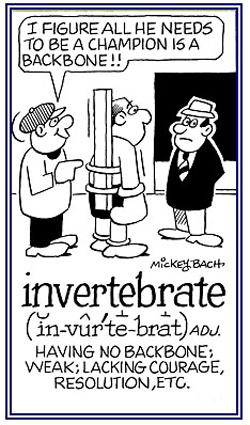vetebro-, vertebr-
(Latin: joint, especially of the spinal column)
Directly related to the vers-, vert-, "bend, turn" family.
An animal or animals living wholly or chiefly in or on water.
basilar vertebra (s) (noun)
The lowest lumbar or hip bone that is connected to the spine: "The term basilar refers to that which is located at or near the base of a structure and in this case, the basilar vertebra is near the bottom of the spine."
One of the bones of the neck or the seven segments of the vertebral column located in the neck area: " The vertebrae are located closest to the skull in the neck."
coccygeal vertebrae (pl) (noun)
The three to five basic segments of the spinal column that is farthest from the skull and which fuse to form the coccyx or tailbone which consists of the small triangular bone at the base of the spinal column in humans and certain apes, consisting of several fused rudimentary vertebrae.
costovertebral
A reference to a rib and a vertebra.
craniospinal, craniovertebral; cerebrospinal
1. Pertaining to the cranium and the spinal, or vertebral, column.
2. Denoting a portion of the central nervous system.
2. Denoting a portion of the central nervous system.
evertebrate
Plates of fibrocartilage placed between two vertebrae (special types of bones that form the spinal column), covering their inferior and superior surfaces: "The intervertebral discs play a primary use in weight bearing and a lesser degree in movement."
"The intervertebral discs or nucleus pulposus (soft moist solid) are fibro-cartilaginous discs that lie between the vertebral bodies in the spine."
These intervertebral disks are composed of a central gelatinous-like material that provide a cushioning or shock absorbing quality to the spinal column to axial stress. The discs may herniate or rupture, resulting in a condition known as a radiculopathy."
invertebrate (adjective), more invertebrate, most invertebrate
1. A reference to animals that do not have a backbone: There are groups of animals with vertebrae, or backbones consisting of small bones fitted together like little beads on a string; and then there are many creatures of different shapes and sizes that do not have backbones, and they are classified as invertebrate animals.

© ALL rights are reserved.
Go to this Word A Day Revisited Index
Some invertebrate species include moths, butterflies, spiders, crayfish, and snails; all of which do not have internal skeletons to support their bodies.
2. Descriptive of those who are "spineless" and who cannot make difficult decisions or they do not have the courage or determinations necessary to fulfill the tasks: There are too many invertebrate people who don't have the "backbones" necessary to overcome difficulties and to achieve success even with important objectives.
Go to this Word A Day Revisited Index
so you can see more of Mickey Bach's cartoons.
invertebrate zoology
The branch of zoology concerned with the taxonomy, behavior, and morphology of invertebrate animals or any animal lacking a backbone and an internal skeleton, including all species not classified as vertebrates
lumbar vertebrae, vertebrae lumbales (pl) (noun)
The bones, usually five in number, located in the lumbar region of the back which is near, or situated in the part of the back and sides between the lowest ribs and the pelvis.
A painful rupture of the fibrocartilage of the disc between spinal vertebrae which occurs most often in the lumbar region of the back.
sacrovertebral (adjective), more sacrovertebral, most sacrovertebral
Referring to that part of the vertebral column immediately anterior to it or in front of it: As part of their written anatomy examination, the students were asked to compare and to contrast the sacrovertebral structures of males and females.
1. One of the bony segments of the spinal column: "Vertebrae are the thirty-three bones of the spinal column, including the seven cervical, twelve thoracic, five lumbar, five sacral, and four coccygeal spinal bones."
2. Any of the bones or cartilaginous segments forming the spinal column.
3. A bone of the spinal column, typically consisting of a thick body, a bony arch enclosing a hole for the spinal cord, and stubby projections which connect with adjacent bones.
2. Any of the bones or cartilaginous segments forming the spinal column.
3. A bone of the spinal column, typically consisting of a thick body, a bony arch enclosing a hole for the spinal cord, and stubby projections which connect with adjacent bones.
vertebral (adjective)
Showing page 1 out of 2 pages of 18 main-word entries or main-word-entry groups.

